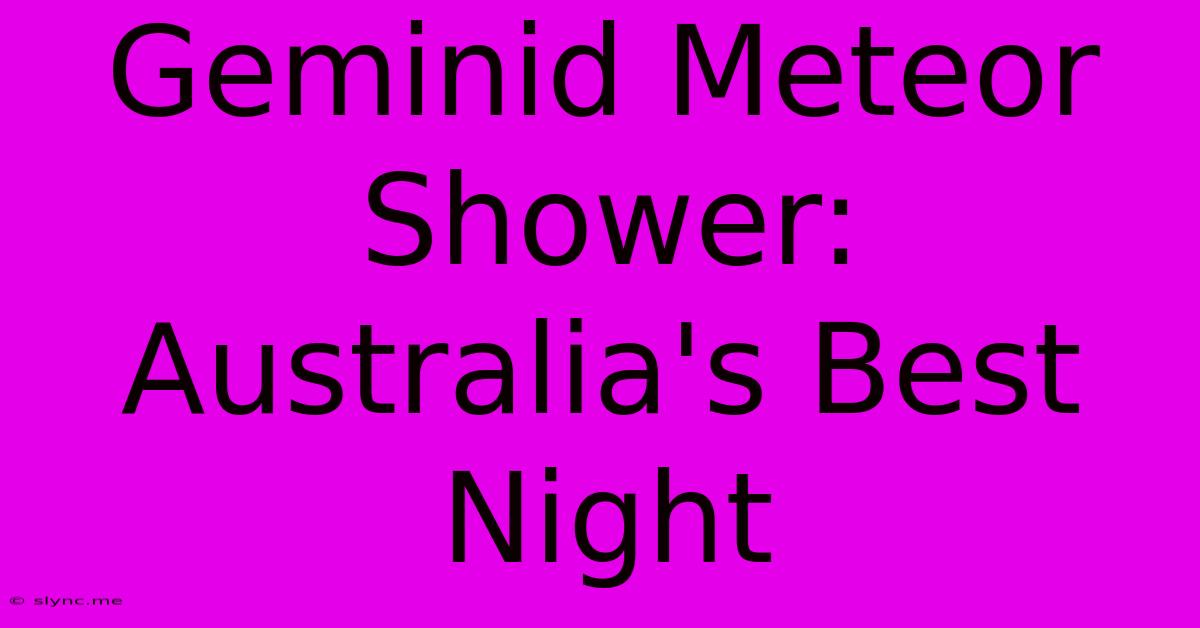Geminid Meteor Shower: Australia's Best Night

Discover more detailed and exciting information on our website. Click the link below to start your adventure: Visit Best Website Mrs.Amykhan. Don't miss out!
Table of Contents
Geminid Meteor Shower: Australia's Best Night for Stargazing
The Geminids, renowned for their vibrant and frequent displays, are set to grace the Australian night sky again this year. Prepare for a celestial spectacle unlike any other – a dazzling meteor shower promising an unforgettable experience for stargazers across the country. This guide will highlight the optimal viewing times and locations in Australia to witness the Geminids at their most spectacular.
When to Witness the Geminid Meteor Shower in Australia
The Geminid meteor shower typically peaks in mid-December, offering Australians a fantastic summer night's entertainment. The exact peak time varies slightly each year, so checking astronomical calendars closer to the date is recommended. However, the nights surrounding the peak offer excellent viewing opportunities. Expect the best viewing between midnight and dawn, as the radiant point (the point in the sky from which the meteors appear to originate) rises higher in the sky during these hours.
Finding the Perfect Stargazing Spot in Australia
Light pollution is the arch-nemesis of any stargazer. To truly appreciate the Geminid meteor shower, escaping city lights is essential. Australia boasts many dark sky locations, perfect for optimal viewing. Some of the best include:
Dark Sky Parks and Reserves:
- Warrumbungle National Park (NSW): This park boasts a certified International Dark Sky Park status, making it ideal for observing celestial events.
- Lake Tyrrell (Victoria): This salt lake provides a stunning, flat landscape with minimal light pollution, reflecting the starry sky beautifully.
- Ayers Rock Resort (NT): Witness the meteor shower against the backdrop of Uluru – a truly unforgettable experience. (Note: Check for any local light shows which may impact visibility).
- Numerous other remote locations: Across Australia's vast outback, there are many locations offering minimal light pollution, providing exceptional viewing opportunities. Research areas away from major cities and towns for the best results.
Tips for Choosing Your Location:
- Check light pollution maps: Websites and apps provide light pollution maps to help you identify dark sky areas.
- Consider accessibility: Ensure your chosen location is easily accessible, especially at night.
- Check weather forecasts: Clear skies are crucial for optimal viewing. Check the forecast before you go.
Maximizing Your Geminid Meteor Shower Experience
- Patience is key: The meteor shower is a spectacle that unfolds over time. Be patient and allow your eyes to adjust to the darkness.
- Bring a blanket or chair: You'll be spending several hours outside, so comfortable seating is essential.
- Dress warmly: Even in summer, nights can get chilly. Dress in layers.
- Avoid looking at your phone: Your phone's bright screen will disrupt your night vision.
- Bring binoculars or a telescope (optional): While not necessary to see the meteors, binoculars or telescopes can enhance your viewing experience by allowing you to observe other celestial objects.
Safety First!
Remember to prioritize safety when venturing out for stargazing:
- Let someone know your plans: Inform a friend or family member of your location and estimated return time.
- Be aware of your surroundings: Pay attention to your environment, especially if you are in a remote location.
- Bring a fully charged phone: In case of emergencies.
- Drive carefully: If you are driving to your viewing location, drive cautiously, especially on unfamiliar roads.
Capture the Magic: Photography Tips
For those wanting to capture the Geminid meteor shower, remember these tips:
- Use a DSLR or mirrorless camera: These cameras offer better low-light performance.
- Wide-angle lens: This captures a larger portion of the sky.
- Tripod: Essential to prevent blurry images during long exposures.
- Long exposure: Experiment with different exposure times to capture more meteors.
The Geminid meteor shower offers a truly breathtaking celestial display. By following these tips and choosing a suitable location, you can ensure an unforgettable night under the Australian stars. Remember to check for specific peak times closer to December and enjoy the show!

Thank you for visiting our website wich cover about Geminid Meteor Shower: Australia's Best Night. We hope the information provided has been useful to you. Feel free to contact us if you have any questions or need further assistance. See you next time and dont miss to bookmark.
Also read the following articles
| Article Title | Date |
|---|---|
| Dexter Episode 1 A Critical Look | Dec 13, 2024 |
| Time Magazine Trumps Second Person Of The Year | Dec 13, 2024 |
| Divitisya Ligu Konferentsiy 12 Grudnya Onlayn | Dec 13, 2024 |
| The Incident That Humanized Ray Hadley | Dec 13, 2024 |
| Unveiling Elden Ring Nightreign New Information | Dec 13, 2024 |
